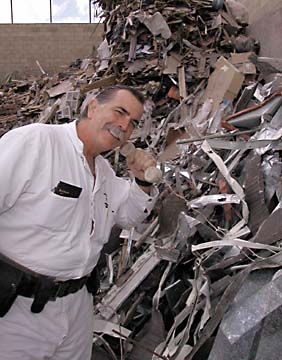

|
TheBuzz Erika Engle |
CRAIG T. KOJIMA / CKOJIMA@STARBULLETIN.COM
Mike Leary started Island Demo Inc. 15 years ago, and now employs 42 people and razes two to three houses a week.
Marking 15 years of
constructive destructionMike Leary started with a wheelbarrow, a sledgehammer and a pickup truck in 1988. Now his Island Demo Inc. is marking its 15th anniversary, 42 employees strong.
A construction laborer, Leary got his first shot at demolition from contractor Glenn Takahashi of Kokea Construction.
Island Demo tears down two or three houses a week, does interior demolition, selective demolition, surgical demolition and selective removal. He works in vacant space, in occupied space and against occupied space, such as work he's done to gut one retail space next to an operating retail space at Ala Moana Center.
"The big thing that we really do is recycle as much of the demolition materials as we can to limit the amount of material going into the landfill, and dispose of that material properly," he said.
Island Demo also does abatement work, which includes asbestos and lead paint removal and soil remediation, which means his workers' comp rates are pretty healthy.
"You have no idea," Leary said.
His first baseyard was in Waimanalo, but the company moved to 2769 Kilihau St. in Mapunapuna in 1996. It now operates Oahu's only licensed inner-city construction debris transfer station. Contractors dump loads at Island Demo, where employees in white jumpsuits sort and process the tonnage before trucking it to a landfill.
Leary estimates that for every 20 loads received, about 30 percent of the volume is taken to the landfill. The majority is recycled, or, in the case of hazardous waste, shipped to the mainland for disposal.
It isn't that he fishes out second-hand materials for others to install in brand new construction or remodeling jobs, although he does find takers for "architectural finds" such as doors and clawfoot tubs.
He sells some items, such as the tubs, though "not for big money." He gives most away. He doesn't have the storage, he says.
The way he sees it, his company helps the community by reducing the truck traffic making long hauls to landfills and extending the longevity of landfills by reclaiming reusable materials.
"I wish there were more Mike Learys," said Suzanne Jones, recycling coordinator for the City and County of Honolulu.
She compared Leary's creativity and vision to that of her 13-year-old son. While she would view plastic six-pack rings as recyclable rubbish, her son sees three pairs of handcuffs.
"We don't think as creatively as we did when we were kids. Mike still sees the value in everything and he brings that approach into his business," she said.
"I wish he was contagious," she said, adding that, in a way, he is.
Leary is an advisory board member of Partnership for the Environment, a city-coordinated coalition of businesses, "that, like Mike, have a commitment to the environment and feel that they need to lead by example and are willing to share their expertise with other businesses."
Island Demo is included in the recycling office's "Tour de Trash" of businesses which model sound waste management and recycling behavior, Jones said. "He takes tour groups and explains his philosophy."
Jones and Leary take a dim view of illegal dumping, which has been the subject of increased attention recently.
"I'm trying to think of how we can change that behavior," she said.
Increased media attention, getting the public to be more watchful for and more willing to report illegal dumpers and then shaming those responsible are ideas on her mind.
"The illegal dumping thing is a high priority right now," Leary said. "If you're going to hire a demo company, know where they're taking that material."
Waste woes
>> By weight or volume, wood, drywall and cardboard make up between 60 percent and 80 percent of job site waste.>> Vinyl and metals are generated in small quantities but have good recycling value.
>> For most builders, the largest share of waste that could be considered hazardous is generated from painting, sealing, staining and caulking.
>> Each year, Hawaii generates more than 1.5 million tons of waste, with more than 500,000 tons of that from construction and demolition projects.
Source: Island Demo Inc.
See the Columnists section for some past articles.
Erika Engle is a reporter with the Star-Bulletin.
Call 529-4302, fax 529-4750 or write to Erika Engle,
Honolulu Star-Bulletin, 500 Ala Moana Blvd., No. 7-210,
Honolulu, HI 96813. She can also be reached
at: eengle@starbulletin.com
